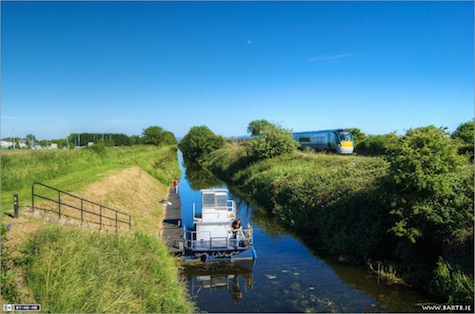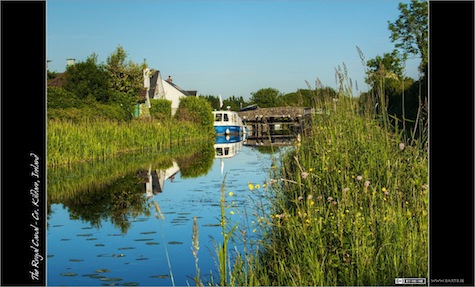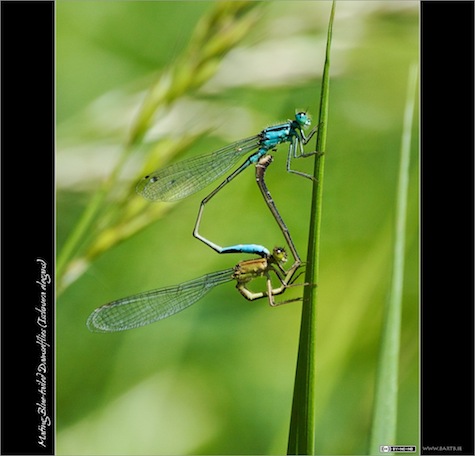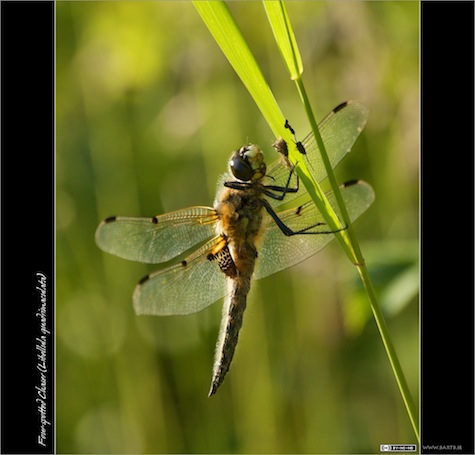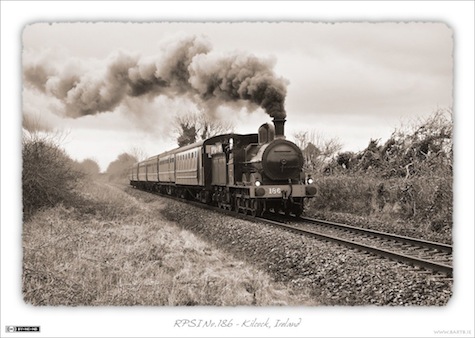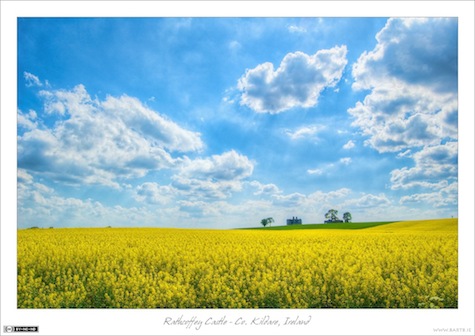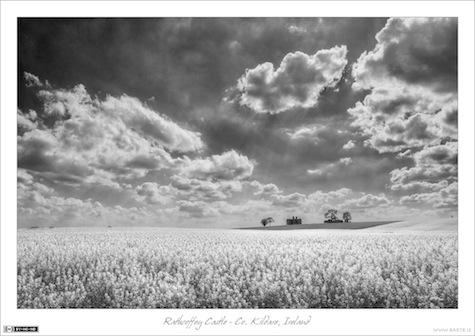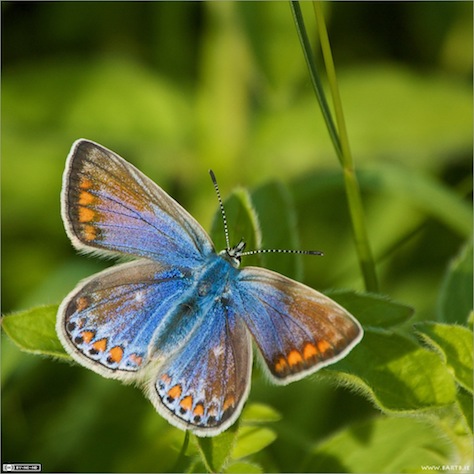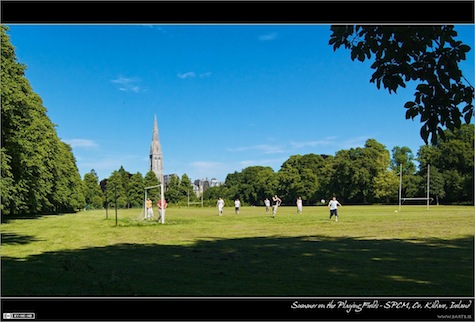Sep
5
There’s been a lot of double posts of late, and this week is no exception. Last week I happily entertaining Allison & Steve from the Nosillacast on the Irish leg of their European tour, so I didn’t get a chance to post. As always with double posts, I’ve chosen two related photos, in this case both of the Royal Canal. The vast majority of my insect and flower shots, as well as many of my train shots, are taken along a 10 mile stretch of this canal from Leixlip to Maynooth to Kilcock. Despite sharing lots of shots taken along the canal, I hardly ever share any shots of the canal, so I thought I’d correct that oversight this week.
The first shot I’ve chosen is taken from Chamber’s Bridge just east of the 15th lock looking east towards Dublin. In the foreground you can see the jetty where boats can tie up while waiting to pass the lock which is directly behind us. The boat tied up at the jetty is a very special boat used by Waterways Ireland to keep the canal clear of too much plant growth. You can also see a guy fishing from the boat, and an evening express train to Sligo passing by on an embankment above the canal.
- Camera: Nikon D40
- Lens: Nikon DX AFS 18-55mm (D40 kit lens)
- Exposure: 1/800 sec
- Focal Length: 18mm
- Focal Ratio: f/8
- ISO: 400
- Camera Mode: Full Manual
- Processing: This image was tweaked a little using the Topaz Adjust 4 plugin in Photoshop Elements 8.
The second shot was taken on the other side of the 15th lock, also looking east. Although the canal has been fully restored around the Dublin area, it’s still a work in progress further west, which means there isn’t much tourism on the canal yet. One of the few places you do see signs of tourism is here at the mooring place just west of the 15th lock. Lets hope views like this become more common all along the Royal Canal.
- Camera: Nikon D40
- Lens: Nikon DX AFS 18-55mm (D40 kit lens)
- Exposure: 1/500 sec
- Focal Length: 55mm
- Focal Ratio: f/11
- ISO: 400
- Camera Mode: Aperture Priority
- Exposure Bias: -0.3ev
- Processing: Generated by tonemapping a single RAW image with Photomatix Pro, and then tweaking the result with the Topaz Adjust 4 plugin in Photoshop Elements 8
Aug
24
Photo of the Week 130 & 131 – Two New Muses
Filed Under Photography | 2 Comments
For a long time now my two favourite subjects have been trains and butterflies, but this year I’ve started to be attracted by two related new muses. Butterflies are probably the most eye-catching insects in Ireland, but I think the largest are the Dragonflies and Damselflies that fill our summer skies. I’ve only been focusing on these guys for a few months, but I’ve already got some pictures I like enough to include here.
The first shot I’ve chosen shows a pair of Blue-tailed Damselflies (Ischnura elegans) making more Blue-tailed Damselflies. Two things to note here, firstly, Damselflies opt for a very unique position for mating, and the males and females have very different colours. Adult males of the different species generally look quite distinct (with a few exceptions), but many of the females of the different species look very similar, some species even have females of a few different colours, and to really confuse things, both males and females change colour as they mature. If you can’t recognise what species a Damselfly is, it’s probably a juvenile, or a female, or both. Butterflies are WAY easier to tell apart!
- Camera: Nikon D40
- Lens: Nikon DX AFS 55-200mm
- Exposure: 1/800 sec
- Focal Length: 200mm
- Focal Ratio: f/8
- ISO: 200
- Camera Mode: Aperture Priority
- Exposure Bias: -1.0ev
- Processing: tweaked a little using Aperture’s Dodge & Burn plugin
The second shot I chose is of the largest Dragonfly I’ve managed to capture so far, the Four-spotted Chaser (Libellula quadrimaculata). These guys are very territorial. They get their name because they chase away other Dragonflies that stray into their patch (and have 4 spots on each set of wings). They like to sit on perches that give them a good view of their territory, and will keep returning to their favourite perches over and over again. This makes them a joy to photograph, if you miss the perfect shot the first time around, just wait a bit, and you’ll get another chance! The fact that they like a perch with a good view also means you tend to be able to get shots with nice clutter-free backgrounds too.
I’ve also started to experiment a lot with back-lighting in the last few months. As this shot demonstrates, it can work nicely on insects which tend to have transparent or semi-transparent bits for the light to shine through.
- Camera: Nikon D40
- Lens: Nikon DX AFS 55-200mm
- Exposure: 1/400 sec
- Focal Length: 200mm
- Focal Ratio: f/8
- ISO: 400
- Camera Mode: Aperture Priority
- Exposure Bias: -1.0ev
- Processing: tweaked a little using Aperture’s Dodge & Burn plugin
Aug
9
Since it’s been a while since I posted a railway shot in this Photo of the Week series, I thought I’d treat myself by posting my favourite steam shot of the year (so far). I chose this location precisely because it’s free from modern distractions. There are no modern houses, no electricity pylons, no modern signals, no modern electronics cabinets, in short, nothing to break the illusion of timelessness. OK – that’s not entirely true. Those of you with a very keen eye will notice the one unavoidable piece of modernity in this shot – the track itself – it’s continuous welded rail on concrete sleepers. You can rest assured that when No.186 was earning it’s keep for the Great Southern & Western Railway it wasn’t running on anything nearly as fancy, smooth, or comfortable! Still – very few people will find the modern track-work a distraction from the timeless beauty of a steam engine hard at work.
For those of you interested in such details, this is RPSI preserved steam loco number 186. She’s a class J15 0-6-0 former GS&WR loco, manufactured in Manchester in 1879, and retained in service until 1964. Here we see her on a cold, windy, and rather damp Easter Monday morning near Kilcock Co. Kildare, working the Easter Egg-spress from Dublin to Mullingar.
- Camera: Nikon D40
- Lens: Nikon DX AFS 55-200mm
- Exposure: 1/640 sec
- Focal Length: 55mm
- Focal Ratio: f/5.6
- ISO: 800
- Camera Mode: Full Manual
- Processing: This shot was first tweaked using the Topaz Adjust plugin in Photoshop Elements 8, then converted to monochrome using the Monochrome Mixer in aperture, and then give a subtle sepia tone using the Colour Monochrome brick in Aperture.
Aug
2
I’ve been on a bit of a break from Photography – a combination of injury and crap-tacular weather, so I have yet another catch-up post to do! As always when I do multiple posts, the two images are related, in this case, very related, being two different treatments of the same RAW image. This shot was taken on the same day as the last monochrome-colour combo I posted (Photo of the Week 111 & 112 – Summer in Rathcoffey), and from a spot only a few hundred feet from where that last shot was taken.
Yesterday I posted some of my thoughts on Photographic composition, and used that post as the basis for a conversation with Allison on episode 271 of the Nosillacast podcast. In that discussion we talked about the importance of getting layers into photographs of places to give a sense of depth, and in particular we talked about the importance of the foreground layer. As part of that discussion I drew attention to the fact that there are a huge amount of possible foregrounds for every background. You can usually move hundreds of feet without making much, if any, change to the background when you’ve shooting landscapes. This gives you a wide menu of foregrounds to choose from.
If you compare and contrast these photos with those from my Photo of the Week 111 & 112 post, you’ll get a good example of just how different a shot you can get by just changing the foreground. Both sets of photos have Rathcoffey Castle as the background, both have the field of flowering Rape Seed flowers as the mid-ground, and both have the same dramatic sky at the top of the frame, but both have very different foregrounds, framings, and compositions, resulting very different photographs.
These shots have a far simpler composition, with far fewer elements in the frame. It really is just the field, the castle, and the sky. The previous shot was about showing the many interesting things around the edges of the field, the beautiful old tree, the ancient Ring Fort, and of course the castle, so it was composed in such a way as to show all these things without cluttering the frame. The filed and the sky were in that shot too, but they were almost incidental. Here, we have much less in the frame, so both the sky and the big sweeping field are the stars of the show, with the castle adding some nice interest to the background, but not being the star of the show.
These two sets of shots were taken very close to each other. The first a little to the left of the Ring Fort, with the Ring Fort included, the other a little to the right of the Ring Fort with it excluded. The Ring Fort is literally just a few pixels off to the right of this shot, but because you don’t see it, you assume it’s not there, and that the field goes on for ever. As it happens it really is a very big field, but doesn’t come across half as well in the shot if you include it’s edges.
As with the previous photos, this pair was generated using the workflow I described on the Typical Shutterbug Podcast.
- Camera: Nikon D40
- Lens: Nikon DX AFS 18-55mm (D40 kit lens)
- Exposure: 1/1250 sec
- Focal Length: 18mm
- Focal Ratio: f/8
- ISO: 200
- Camera Mode: Aperture Priority
- Processing: single RAW image first tonemapped with Photomatix Pro, then tweaked with the Topaz Adjust 4 plugin in Photoshop Elements
- Camera: Nikon D40
- Lens: Nikon DX AFS 18-55mm (D40 kit lens)
- Exposure: 1/1250 sec
- Focal Length: 18mm
- Focal Ratio: f/8
- ISO: 200
- Camera Mode: Aperture Priority
- Processing: single RAW image first tonemapped with Photomatix Pro, then tweaked with the Topaz Adjust 4 plugin in Photoshop Elements, and finally converted to monochrome using the Channel Mixer in Apeture
Jul
31
Some Thoughts on Composition
Filed Under Photography | 8 Comments
Initially I’d started writing these thoughts up as bullet points to use as show-notes for this weekend’s Chit Chat Across the Pond segment on the NosillaCast, but as I worked on them I realised they were worth developing into a full blog post. The aim here is to share some of my thoughts on composing photos. A lot of people think that the difference between a snapshot and a professional looking photo is the camera, which is true to some extent, but a much more important factor is the composition. I believe that the single most important thing you can do to improve your photography is to work on your composition. Thankfully, a little effort goes a long way, so it’s time very well spent.
Jul
24
Review of Money3 by Jumsoft
Filed Under Computers & Tech | 12 Comments
THe week before last I posted a description of the final stages of my quest for a new personal finance app, and explained how I came to choose Money3 from Jumsoft, what I didn’t do was actually review the product though, so I thought I’d do that now. On the one hand I’ve only been using this product for a week and a half, but on the other I’ve been using it a LOT during that week and a half. In that time I’ve entered all the transactions for 2010 on six accounts covering all my personal and business transactions so far this year. That’s a lot of time using the software, so I think I’ve got a good flavour of what it’s like to really use it.
Jul
18
I have quite a few good butterfly shots in reserve for future Photo of the Week posts, but I want to keep things nice and varied, so I’m only going to be posting one every few weeks. Since it’s been over a month since I shared a butterfly shot, I figure it might be time to share another.
This is a shot that I had been chasing for over a year when I finally managed to captured it last month. The Common Blue butterfly (Polyommatus icarus) is very small, and very camera shy, but also very beautiful. The male’s back is plain electric blue, which is pretty spectacular, but the female takes things to a whole new level, having a beautiful mix of browns, blues, and oranges on her back. The patterns at the tips of her wings are both intricate and beautiful. Many people consider this the most colourful Irish butterfly, though I disagree, I think that honour should go to the Peacock Butterfly. Regardless of whether or not it’s the most colourful butterfly, it’s certainly one of the most beautiful.
The best chance you’ll get to capture the back of these fine lady’s wings is in the evening time. As the wind falls and the sun gets low in the sky, you’ll sometimes find them sun-bathing on top of tall stalks of grass or wild flowers like thistles with their wings open. If you approach very slowly and very carefully with a long enough lens you have a chance of getting off a good shot. I took this one on a beautiful still and clear summer evening along the banks of the Royal Canal near Deey Bridge and the 13th lock with my 55-200mm zoom zoomed in all the way to 200mm.
- Camera: Nikon D40
- Lens: Nikon DX AFS 55-200mm
- Exposure: 1/400 sec
- Focal Length: 200mm
- Focal Ratio: f/8
- ISO: 400
- Camera Mode: Aperture Priority
- Exposure Bias: -0.7ev
- Processing: This shot was tweaked a little using Aperture’s Dodge & Burn plugin to selectively add brightness, contrast, and saturation to the butterly
Jul
15
A few months ago I started my quest to replace Cha-Ching because of how bad my experience with their 2.0 beta was, and how poor their support response was (I got no response at all). I outlined the choices I’d been considering at that stage in part 1 of this article. Since that post there’s been a few developments, and as of this afternoon, I think my quest is at an end.
Jul
11
I’m not even the smallest bit of a football fan, but given that it’s World Cup final weekend, I figured this would be a good time to share one of my few football photos. As well as being beautiful, the grounds of St. Patrick’s College provide a great amenity for the people of Maynooth. Here we see some local lads enjoying a kick-around on one of the pitches on the so-called Playing Fields a fantastic summer afternoon. In the background you can see the spire of the Gunne Chapel (the college chapel).
- Camera: Nikon D40
- Lens: Nikon DX AFS 18-55mm (D40 kit lens)
- Exposure: 1/1000 sec
- Focal Length: 18mm
- Focal Ratio: f/8
- ISO: 400
- Camera Mode: Aperture Priority
- Exposure Bias: -0.7ev
- Processing: This shot was edit using both the Topaz Adjust and Topaz Detail Photoshop plugins.
Jul
6
I though today might be a good time to share another snapshot of my on-going project to Map all Belgium’s railways, past, present, and even to some extent future, with Google Earth. This snapshot is much more complete than the last one, though I still don’t consider it even close to finished.







